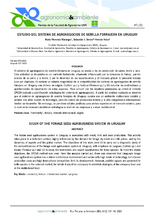RESUMEN.- El sistema de agronegocios de semilla forrajera en Uruguay se asocia a los de producción de carne, leche y lana. Esta actividad se desarrolla en un contexto turbulento, altamente influenciado por la demanda de forraje, por los precios de la carne y la leche, y por la dinámica de las exportaciones y el mercado global. El presente trabajo tuvo por objetivos:(i) realizar un estudio diagnóstico de la competitividad del sistema de agronegocios de semilla forrajera en Uruguay con énfasis en raigrás (Lolium sp.) y festuca (Festuca sp.) y (ii) estudiar las restricciones y oportunidades de exportación de estas especies. Para cumplir con los objetivos planteados se utilizó el método EPESA (estudio y planificación estratégica del sistema de agronegocios). A partir del análisis realizado se observó que el sistema de agronegocios de semilla forrajera de Uruguay cuenta con un ambiente institucional estable y actores con altos niveles de tecnología, pero los costos de producción interno y la alta competencia internacional limitan su desarrollo. Sin embargo, se perciben señales positivas para ambas especies en el mercado externo, para lo cual sería necesario establecer estrategias a nivel de las empresas y a nivel institucional. -- .-.-.-.-.-.-.-.-.-.-.-.- ABSTRACT.- The fodder seed agribusiness system in Uruguay is associated with meat, milk and wool production. This activity takes place in a turbulent context, highly influenced by the demand for forage, by meat and milk prices, and by the dynamics of exports and the global market. The objectives of this work were (i) to carry out a diagnostic study of the competitiveness of the forage seed agribusiness system in Uruguay, with emphasis on ryegrass (Lolium sp.) and fescue (Festuca sp.) and (ii) to study the restrictions and export opportunities for these species. To meet the stated objectives, the EPESA method was used. From the analysis carried out, there was observed that Uruguay's forage seed agribusiness system has a stable institutional environment and actors with high levels of technology, but internal production costs and high international competition limit its development. However, positive signals are perceived for both species in the external market, for which it would be necessary to establish strategies at the company level and at the institutional level.

